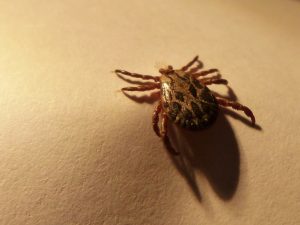
Ticks and Lyme Disease
Lyme Disease is caused by a spiral-shaped bacterium called Borrelia burgdorferi. Ticks that are infected transfer Lyme Disease when they bite us or our pets. Treatment for Lyme disease must occur in a timely manner or may result in a wide range of symptoms including acute facial paralysis, fever, muscle pain, and others.
In 1977, in a town called Old Lyme in the state of Connecticut (US) Lyme disease was identified . A group of boys, who played in the forest areas was subsequently infected by the bacterium. The boys showed symptoms of rheumatoid arthritis. Since then Lyme disease has spread around the world and primarily occurs in the United States, Europe, and Asia.
Some Details About Lyme Disease
Many species of ticks can carry the bacterium. The bacteria infects approximately 20 percent of all ticks in the world. Exposure to Lyme disease can occur in a number of environmental habitats including areas with trees, fields, hiking trails with long grass and forests. The risk factors for contracting Lyme disease include a number of outdoor activities such as walking in grassy areas, hiking, gardening, camping, and importantly contact with our own pets.
Lyme disease infections have two distinct phases. Initially, there is an acute infection. The acute phase occurs after an infected tick bites a person and transmits the bacteria. The acute infection often looks like reddish-blotchy skin reaction but does not always appear the same for everyone. Some people also describe feeling like they have the flu, very tired and/or joint pain.
The second phase is known as the chronic phase and can severely affect the central nervous system of the body. This phase of the infection may include sensitivity to light and sound, anxiety, chronic insomnia, and other symptoms such as neurological and cardiac problems.
What To Do About Lyme Disease?
A proactive approach is the best way to deal with Lyme disease: 1) Always check yourself and others after spending time in any environment that may contain ticks 2) Become familiar with what different types of ticks look like 3) Know what the ‘typical’ acute tick infection may look like 4) Prepare and know how to safely remove a tick
Not all people react the same to Lyme disease infection and may NOT show the typical reddish-blotchy skin reaction.
Detecting Lyme Disease
The incubation period, which is the time it takes for the bacteria to infect a person after they are bitten by an infected tick and develop symptoms is approximately 7-14 days. Lyme disease is confirmed by a blood test; however, during the acute phase, it is common for people who are infected to show a false-negative result. A false-negative means there is no evidence of the disease when in reality, a person is infected. It is important to repeat the blood test when the initial test result is negative but there are symptoms of Lyme disease.
What You Need to Remember
Lyme disease is a serious infection and it is important to remember that the majority of ticks in our environments are not infected with the Borrelia burgdorferi bacteria. Similarly, there are many people, who are bitten by an infected tick but will not contract Lyme disease. For those who are bitten and subsequently become infected, the acute stage of the disease does not always result in the typical red rash. It is important to know that the majority of people, who have contracted Lyme disease did not know they had a tick on their body. Also, most people who develop an infection did not realize they were bitten. The best approach is proactive action.
Before you engage in outdoor activities, take the time to find out if ticks in the area have tested positive for the infectious bacteria. Also, make sure you complete an inspection to people and pets after you’ve been outside. Perform the inspection slowly and be as methodical as you can because some types of ticks are so tiny they can be very difficult to see or feel.
If you find a tick do not panic. The tick MUST be attached for 24-36 hours in order to transmit the bacteria that causes the infection so there is always time to remove the tick if you check regularly.


